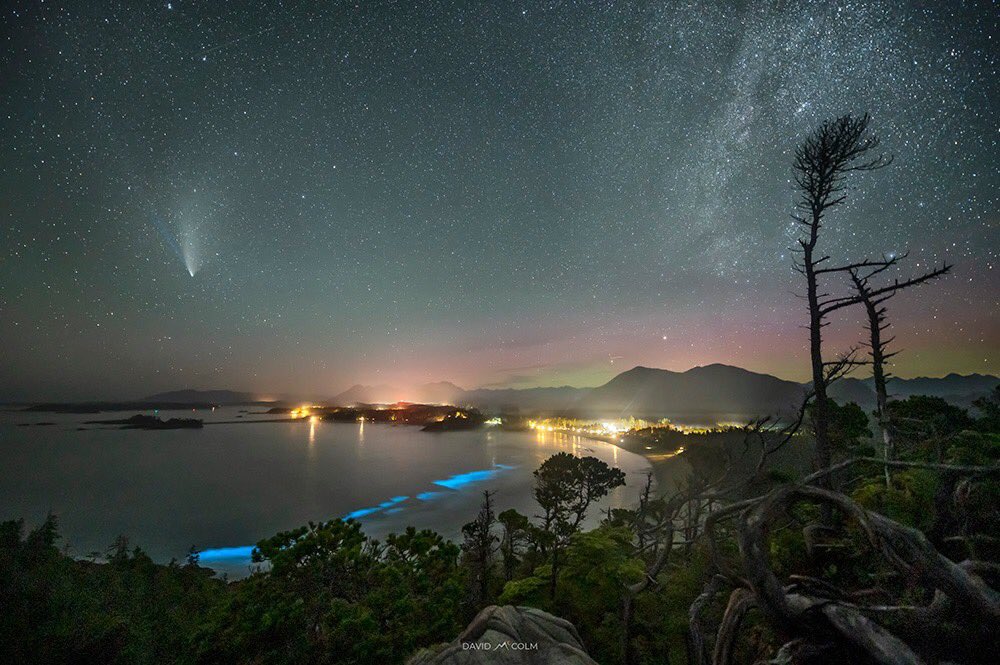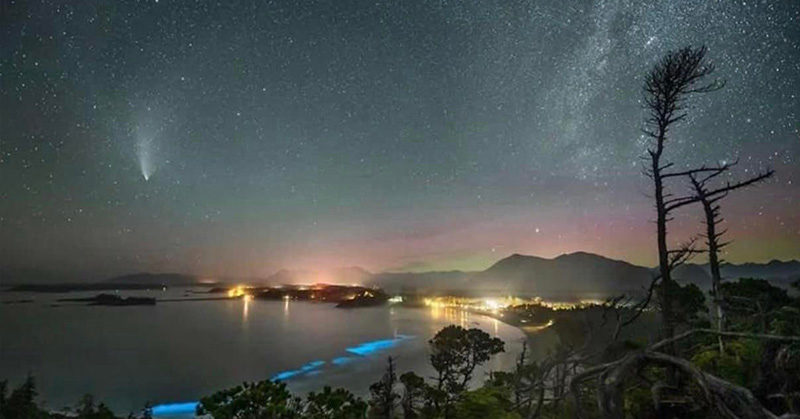It is said that a picture is worth a thousand words, but sometimes they instead leave you speechless. This is the case with this spellbinding image captured by a B.C. photographer of a rare comet, the Northern Lights, Milky Way, and bioluminescence. Check out the incredible rare beauty captured in this photo.
Spellbinding Image Captures Four Rare Sights in One
Snapping a gorgeous image of just one of these incredible occurrences is impressive. A photo that contains all four? Absolutely incredible.
British Columbia-based landscape and night sky photographer David McColm went out in late July to attempt to capture one last shot of the rare NEOWISE comet that was passing over Tofino, B.C. He not only caught the comet, but also the Milky Way, bioluminescence, and a bit of aurora. He shared the spellbinding image on his Twitter, leaving everyone’s jaws definitively on the ground. (1)

The NEOWISE Comet
This rare comet was first discovered by NASA’s Neowise infrared telescope back in March. The last time a comet like this one was viewable in the Northern Hemisphere was comet Hale-Bop in 1977. (1)
Only July 3, NEOWISE reached its closest point to the sun, which caused this “frozen ice ball” to heat up, burning gas and dust off of its surface.(1) NASA explains this on their website:
“The comet cruised just inside Mercury’s orbit on July 3. This very close passage by the Sun is cooking the comet’s outermost layers, causing gas and dust to erupt off the icy surface and creating a large tail of debris. And yet the comet has managed to survive this intense roasting.” (2)
McColm has shared a number of amazing images he took of the comet over B.C., however, none are as beautiful as this last one he took over Harrison Lake. (1)
Read: Photographer ‘Accidentally’ Captures Incredible Photos of a Brilliant Green Meteor
The Milky Way
The Milky Way is a galaxy, or a large group of stars, gas, and dust bound together by gravity. Our sun, which is actually a star, is part of it, as well as all of the planets surrounding it. The Milky Way is a barred spiral galaxy, though other galaxies are different shapes and sizes than ours. (3)
All of the stars we see from the earth are part of The Milky Way. It gets its name because in dark areas when the sky is clear, it looks like a milky band of white in the sky. (3)
Aurora Borealis
Also known as The Northern Lights, Aurora Borealis is the beautiful, colorful, dancing lights best seen in the most northern parts of the northern hemisphere, such as northern Canada and Norway. (4)
These beautiful light shows are actually created by collisions between gaseous particles in the Earth’s atmosphere and charged particles released from the sun’s atmosphere. The different colors are caused by different types of gas particles in the collisions. (4)
For example, red auroras are created by high-altitude oxygen, yellowish-green by lower altitude oxygen, and blue or purplish-red are produced by Nitrogen. (4)
Read: Photographer Snaps Once-in-a-Lifetime Shot of a Rainbow Sky
Bioluminescence
Bioluminescence refers to the patches of glowing blue in the water seen in McColm’s photo. These are caused by a natural chemical process that allows living organisms to produce light in their bodies. Many marine animals use this to either discourage prey or attract a potential meal, however, the ones we often see near shore are caused by an algae bloom of plankton. The breaking or splash of a wave at nighttime causes the boom to glow, producing a beautiful blue light close to shore. (5)
In order for this to occur, the water needs to be warm and relatively calm. (5)
A Career Best
It is without a doubt that this photograph will be one of McColm’s favorite photos for a very long time. A rare opportunity where he was in the right place at the right time. Bravo, David McColm!
Keep Reading: Upcoming Meteor Showers In 2020 You Just Can’t Miss
- https://www.piquenewsmagazine.com/must-reads/spellbinding-image-rare-comet-northern-lights-milky-way-bioluminescence-bc-photos-2599244
- https://www.nasa.gov/feature/jpl/comet-neowise-sizzles-as-it-slides-by-the-sun-providing-a-treat-for-observers
- https://imagine.gsfc.nasa.gov/science/objects/milkyway1.html
- https://www.northernlightscentre.ca/northernlights.html
- https://www.environment.sa.gov.au/goodliving/posts/2018/04/sea-sparkle

